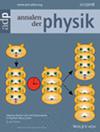An Algebraic Roadmap of Particle Theories
IF 2.5
4区 物理与天体物理
Q2 PHYSICS, MULTIDISCIPLINARY
引用次数: 0
Abstract
An optimal algebraic framework of particle physics has a number of checkpoints to pass. As a minimum, models should conform to the Coleman-Mandula theorem (or establish a loophole), evade familiar fermion doubling problems, naturally explain the Standard Model's chirality, exclude B-L gauge symmetry at low energy, and explain the existence of three generations. The framework introduced in ref. [1] is shown to passes checkpoints , and has yet to cross . The discussion is concluded by elucidating an unexpected appearance of spacetime symmetries.

粒子理论的代数路线图
粒子物理学的最佳代数框架需要通过一系列检查点。至少,模型应该 ⟨ 1 ⟩ $\langle 1 \rangle$ 符合科尔曼-曼杜拉定理(或者建立一个漏洞), ⟨ 2 ⟩ $\langle 2 \rangle$ 规避我们熟悉的费米子倍增问题、 ⟨ 3 ⟩ $\langle 3 \rangle$ 自然地解释了标准模型的手性,⟨ 4 ⟩ $\langle 4 \rangle$ 排除了低能下的B-L规对称,⟨ 5 ⟩ $\langle 5 \rangle$ 解释了三代的存在。ref.[1 ⟨ 1 ⟩ , ⟨ 2 ⟩ , ⟨ 3 ⟩ 、 ⟨ 4 ⟩ $\langle 1 \rangle, \langle 2 \rangle, \langle 3 \rangle, \langle 4 \rangle$ ,并且尚未穿过 ⟨ 5 ⟩ $\langle 5 \rangle$ 。讨论的最后阐明了时空对称性的一个意想不到的现象。
本文章由计算机程序翻译,如有差异,请以英文原文为准。
求助全文
约1分钟内获得全文
求助全文
来源期刊

Annalen der Physik
物理-物理:综合
CiteScore
4.50
自引率
8.30%
发文量
202
审稿时长
3 months
期刊介绍:
Annalen der Physik (AdP) is one of the world''s most renowned physics journals with an over 225 years'' tradition of excellence. Based on the fame of seminal papers by Einstein, Planck and many others, the journal is now tuned towards today''s most exciting findings including the annual Nobel Lectures. AdP comprises all areas of physics, with particular emphasis on important, significant and highly relevant results. Topics range from fundamental research to forefront applications including dynamic and interdisciplinary fields. The journal covers theory, simulation and experiment, e.g., but not exclusively, in condensed matter, quantum physics, photonics, materials physics, high energy, gravitation and astrophysics. It welcomes Rapid Research Letters, Original Papers, Review and Feature Articles.
 求助内容:
求助内容: 应助结果提醒方式:
应助结果提醒方式:


